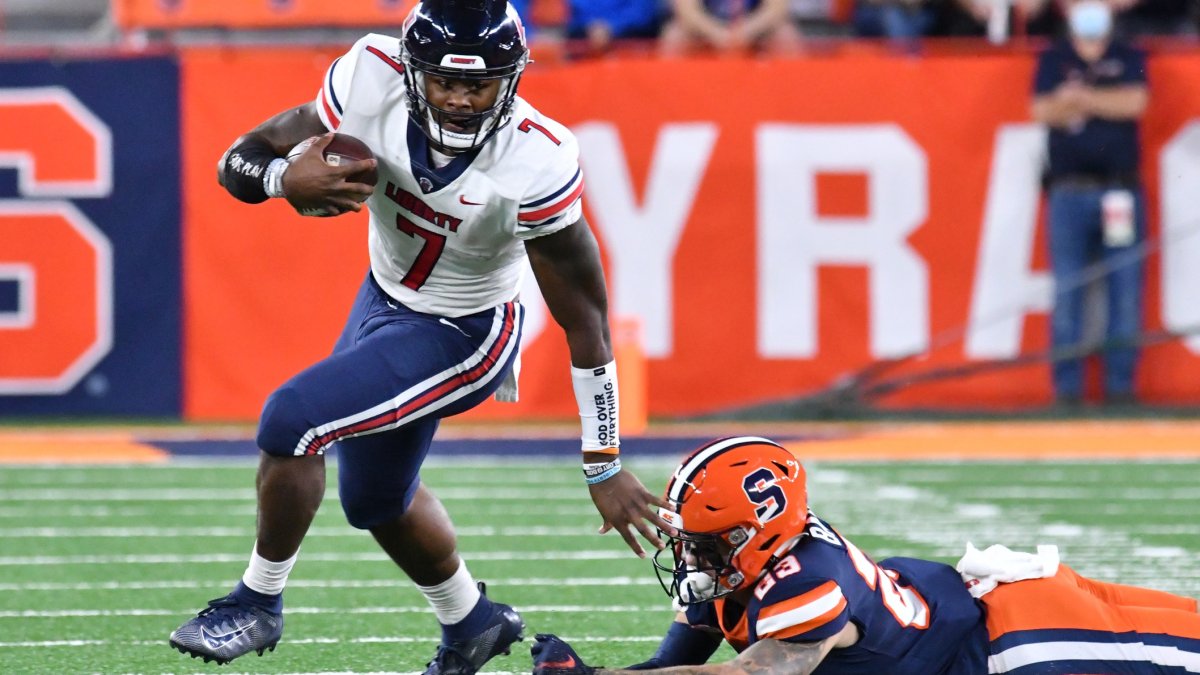Dual-threat players are a bit of a cheat code in the fantasy football world. Quarterbacks that run, running backs that catch and even the occasional wide receiver (or tight end) rush attempt provide a newfound avenue to production that the majority of players at each position don’t offer.
The wild part about this ability for quarterbacks is the reality that they don’t even need to run that much. Even with a relatively modest threshold of 80 rush attempts in a year (five per game in 16-game seasons, 4.7 now), we can see that investing in mobile quarterbacks has been good for fantasy business.
- 41 QBs have racked up at least 80 rush attempts in a season since 2010.
- 27 of 41 (66%) qualified dual-threat QBs finished as a top-12 overall scorer at the position.
- 29 of 41 (71%) qualified run-heavy signal-callers finished as a top-12 QB in fantasy points per game.
- The only QBs from this group that failed to supply at least top-20 production were 2015 Alex Smith (pre-Tyreek Hill), 2013 Terrelle Pryor (numbers flawed a bit from playing, but not starting, two games), and 2018 Lamar Jackson (same thing except more extreme with seven starts vs. 16 games played).
Obviously, having an absurd rushing floor isn’t the end-all-be-all for the position; fantasy football managers weren’t too mad about having Tom Brady or Justin Herbert under center in 2021. Still, it certainly helps matters, especially when we can identify low-ADP first-year talents at the position who might offer this hidden upside.
Seven rookie quarterbacks have finished as a top-12 fantasy signal-caller since 2010. The two common characteristics for everyone except Herbert were a demonstrated rushing floor and the opportunity to start in Week 1. Note that the Chargers’ wildly successful rookie boasted enough athleticism to function as a more productive rusher at the NFL level and found himself under center for good in Week 2.
Seven rookies have finished as QB1s since 2010. The following are their rushing yards per game in college:
- Cam Newton (105)
- Kyler Murray (72)
- Dak Prescott (65)
- Robert Griffin (55)
- Russell Wilson (28)
- Andrew Luck (25)
- Herbert (13)
What follows is a ranking of the 2022 draft’s quarterbacks based on their potential to rack up rushing production. This is not an objective ranking on athleticism or speed; we’re looking for guys that have combined their natural talents with a consistent willingness to attack defenses with their legs. We’ll just focus on signal-callers inside of the top-105 on PFF’s 2022 NFL Draft Big Board in an effort to zero in on those drafted inside of the first three rounds, since it’s incredibly rare, albeit not impossible, for Day 3 rookies and beyond to earn a starting job under center by Week 1.
1. Liberty QB Malik Willis
Willis is special with the ball in his hands.
Malik Willis running around, being cool pic.twitter.com/jifeg837SC
— Ian Hartitz (@Ihartitz) April 5, 2022
He racked up 1,822 yards and 27 scores on the ground in 23 games at Liberty. His rather robust average of 79 rushing yards per game is further accentuated by some borderline erotic advanced numbers:
- PFF rushing grade: 93.4 (No. 1 among 97 quarterbacks with at least 100 rush attempts over the past two seasons)
- Yards per carry: 8.1 (No. 1)
- Yards after contact per carry: 4.7 (No. 3)
- Missed tackles forced per carry: 0.48 (No. 1)
Overall, only Lamar Jackson (8.6) averaged more yards per carry than Willis (8.4) among all college quarterbacks with at least 100 rush attempts since 2015. Pretty good company.
The position’s most dynamic crown should continue to rest on Jackson’s head even once Willis is drafted, but the incoming rookie will be an easy top-five rushing quarterback the second he steps foot on a professional field. Reasonable arguments could be made for immediate second-place treatment, though I’d rank Jackson and Kyler Murray ahead of him.
It’s far from a given Willis will start sooner rather than later; just realize history tells us top-10 picks usually wind up starting 10-plus games. Willis will immediately be in fantasy’s QB1 discussion upon seizing a starting job thanks to his cheat-code potential to rack up double-digit rush attempts per game. Quarterbacks tend to run less as they get older; it’d make sense if Willis and his future employer lean on this facet of his game more than ever in Year 1.
2A. North Carolina QB Sam Howell
Howell's rushing goodness would likely be getting far more attention without Willis as the year's clear No. 1. Either way: The three-year North Carolina starter showed a newfound ability to rack up yards on the ground last season, converting 183 carries into 828 yards and 11 scores. His career average of 27 rushing yards per game qualifies him with our aforementioned high-performing rookie group.
Most impressive was the manner in which Howell picked up his yardage. Willis led the nation with 90 broken tackles, but Howell finished in third place with 65. Willis (0.6) was the only quarterback to make defenders miss at a higher rate than Howell (0.48).
Sam Howell rushing highlights are a fun time pic.twitter.com/ZY4tPg121c
— Ian Hartitz (@Ihartitz) April 18, 2022
Of course, Howell is a bit different when it comes to his real rushing ceiling. His first two seasons as a starter demonstrated the reality that he's more than willing to abandon his legs in favor of throwing; it was only after North Carolina lost the likes of Javonte Williams, Michael Carter, Dyami Brown and Dazz Newsome that Howell began to shoulder the load on the ground.
Howell isn't overly physically imposing (6-foot-1, 220-pounds) and posted some rather brutal numbers in the 40-yard dash (5.07 seconds) as well as the vertical jump (24.9 inches) as a high school recruit.
Still, volume is volume, and Howell proved willing to rack up more than just about anyone than Willis in 2021. He won’t be in the same QB1 conversation as Willis if/when a starting opportunity arises, but that doesn’t mean the 21-year-old talent can’t add a fantasy-friendly rushing floor to whatever he’s able to accomplish as a passer.
2B. Ole Miss QB Matt Corral
Corral measures out as a better athlete than Howell based on his high school numbers in the 40 (4.8 seconds) and vertical (29.9 inches), although expecting him to run with the same sort of willingness at just 205 pounds might be wishful thinking. Both Howell and Corral played 37 career games, with the former quarterback posting double-digit rush attempts in 22 games compared to 19 for the latter. While Corral (37 rush yards per game) was more consistent throughout his career, Howell showed a better one-year ceiling.
Ultimately, it’s a tossup between Howell and Corral behind Willis; I have them tiered as 2A and 2B. Look no further than Corral's 30-195-0 performance against Tennessee to see what he’s capable of achieving on the ground. The tiebreaker came down to Howell's superior performance on designed runs. The following metrics are from 2021 and don't include scrambles:
- Howell: 76 carries-604 yards-7 TD, 8.0 YPC, 0.46 missed tackles forced per carry, 24 runs of 10-plus yards
- Corral: 74 carries-398 yards-10 TD, 5.4 YPC, 0.26 missed tackles forced per carry, 19 runs of 10-plus yards
Like Howell, Corral doesn’t profile as the sort of high-volume rusher capable of supplying immediate QB1 fantasy value, but his legs should give him an underrated floor if/when he gets the chance to start somewhere.
2C. Cincinnati QB Desmond Ridder
Ridder posted some truly elite numbers at the combine:
- 40-yard dash: 4.52 seconds (No. 1 among all quarterbacks who tested)
- Vertical jump: 36 inches (No. 1)
- Broad jump: 10 feet-7 inches (No. 1)
- Three-cone drill: 7.15 seconds (No. 4)
- 20-yard shuttle: 4.29 seconds (tied for No. 3)
Here's the catch: Ridder ran less, not more, as his collegiate career progressed. This is probably a good idea for his aspirations of being a good real life quarterback, but it's not ideal in fantasy land. Overall, Ridder averaged a relatively modest 7.9 rush attempts per game in 2021 after utilizing his legs far more frequently in 2018 (11.5), 2019 (11.1) and 2020 (9.8) alike.
Ridder (4.9 yards per carry, 0.08 missed tackles forced per carry) wasn't even comparable to Howell (8.0, 0.46) or Corral (5.4, 0.26) when it came to consistently picking up yards and making defenders miss on designed runs last season.
The four-year starter averaged a robust 43.6 rushing yards per game throughout his career. Ridder joins Howell and Corral as quarterbacks with fantasy-friendly rushing floors, albeit nothing that resembles early-career Lamar Jackson or Jalen Hurts. Perhaps Ridder’s advantage in straight-line speed proves superior at the next level, but I rank him just behind both Howell and Corral due to the steep dropoff in shiftiness and 2021 volume.
5. Pittsburgh QB Kenny Pickett
Pickett constitutes our first quarterback who isn't expected to supply much of a fantasy-friendly rushing floor at the next level. This isn’t to suggest he is a statue in the pocket; his fake slide touchdown was truly masterful. Still, Pickett posted a pedestrian 28-40-3 rushing line on non-scrambles while only forcing five total missed all season.
Pickett posted the same 20-yard shuttle time as Ridder and ran plenty solid in the 40-yard dash at 4.73 seconds. Maybe the best is still to come, although his collegiate rushing ceiling simply paled in comparison to our top-four signal-callers:
- Willis: 21 games with at least 50 rushing yards (60% of his career games)
- Howell: 8 (22%)
- Corral: 10 (27%)
- Ridder: 18 (36%)
- Pickett: 7 (13%)
Comps to Tony Romo seem appropriate for Pickett’s rushing ability: He’s capable of making the defense pay if unaccounted for and should supply plenty of off-script goodness, but expect a pass-first mindset and minimal designed-run usage.
6. Western Kentucky QB Bailey Zappe
Zappe rushed for just 71 yards in 14 games in his only season as a starter at Western Kentucky. His 4.88-second 40-yard dash is underwhelming, as is his overall size (6-foot-1, 215-pounds).
Only twice in 2021 did Zappe reach 10 rushing yards, and he never surpassed 24 in a single game. Zappe didn’t lead the country in passing yards and touchdowns by looking to run; don’t expect that mindset to change at the next level due to the reality that he doesn’t exactly possess the physical tools to do much different.
7. Nevada QB Carson Strong
Strong has a serious knee issue called “Osteochondritis dissecans.” I’m not a doctor, but Wikipedia describes it as the following:
“People with OCD report activity-related pain that develops gradually. Individual complaints usually consist of mechanical symptoms including pain, swelling, catching, locking, popping noises, and buckling / giving way; the primary presenting symptom may be a restriction in the range of movement.”
Strong totaled -305 career rushing yards at Nevada. Negative-305! An impossibly immobile statue of a quarterback with a degenerative knee issue seems like a safe bet at the bottom of this list.




 © 2024 PFF - all rights reserved.
© 2024 PFF - all rights reserved.